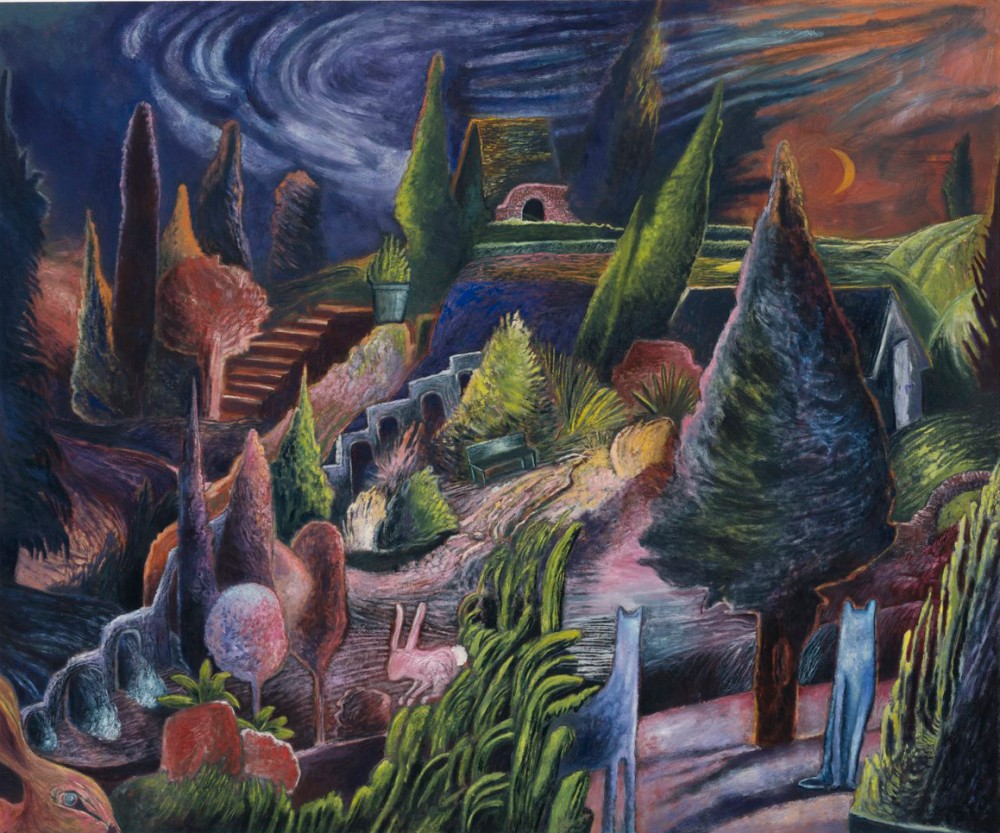
Raymie Iadevaia: To the Ends of the Earth
The Pit is delighted to present To the Ends of the Earth, an exhibition of new oil paintings by Los Angeles-based artist Raymie Iadevaia. The exhibition will be on view at The Pit Los Angeles from January 14–February 18, 2023 with an opening reception on January 21, 2023 from 5–7pm.
Raymie Iadevaia’s first solo exhibition with the gallery features ten new oil paintings packed with “scattered architecture, rocks, plants, trees, and animals that roam forever through circadian passages.” If taken as archetypal documentary, Iadevaia’s dream images reveal an artist-architect as visionary as Antoni Gaudí or Friedensreich Hundertwasser: daisies, cypress trees, turtles, geodes, and tropical leaves sprout out of prehistoric, Piranesi-like compositions mazed with dead-end viaducts, fairy tale castles, Maneki-neko cat-paw ocean waves, 5000 Fingers of Dr.T-like staircases, and O’Keeffe-ian cloud arrays. One can’t deny the brilliance of these Fauvist colors! LA’s golden hour cross-bred with hyper-vigilant ultramarine coral reef, Van Gogh sienna-tripping on climate change; humid, sultry greens; melancholic raisin palettes reminiscent of clammy pre-migraine nausea. Interpolating tones a bit further—let’s say through Goth Romantic pathetic fallacy—Iadevaia implants broodishness into each sublime scene, maybe as a homeopathic cure for anxiety. He says any claustrophobia in these compositions derives from a morning drawing ritual started during pandemic-quarantine, gazing out towards Griffith Park from his Los Feliz apartment’s picture window.
Like Gene Wilder’s “tunnel of terror” scene in Willy Wonka and the Chocolate Factory, these paintings are Baudrillard-ian exercises in simulacra and simulation, not pre-conceived. They remind viewers that contemporary imaging of clusterfuckery, replication, and fantasy modulation pre-date Modernism by eons. For example, Iadevaia mentions Jack Smith, Joseph Conrad’s Heart of Darkness, Hiroshige Hokusai, and art historical use of miseen abymes (in which copies of images are embedded in images to convey recurrence and infinity) in one fell swoop when brainstorming about how these landscapes became so malleable, floating, and spatially illogical. The compositions conjure suspensions of time; downward spirals; distorted, constantly shifting parameters.
Heavy-handed psychological reads may be fun, but truly are slippery and mistaken. Making paintings this unexplainably weird and obsessive only happens in a witch’s cauldron. Cats remind us of this fact, as feline tour guides lead viewers through worlds that subconsciously toss graphic shorthand into wild aesthetic stews: pulp fantasy art; Funk Art’s star Roy De Forest; the rotoscoped, abstract animations of Oskar Fischinger; Edo-period Ukiyo-E. There’s plenty to riff on if solely studying paint’s movement. Using dirty brushes, for example, helps to achieve these scuttled, “cakey flakey” effects, and Iadevaia happily describes his “poetics of oil paints” during which oxidation is invited into breathing layers of pigment that opt less for varnishes and solvents in favor of material moments that feel raw: “jumpstarted or defrosted.” Flora and fauna host some botanical accuracy but are mostly gift-wrapped in what the artist calls “liquid feelings and smoky vapors.” Huff and puff uphill, rest awhile, wander back down, drive out to the coast for a dip. Pet your kitty. Life in LA never quits, carries resplendent nostalgias all its own.